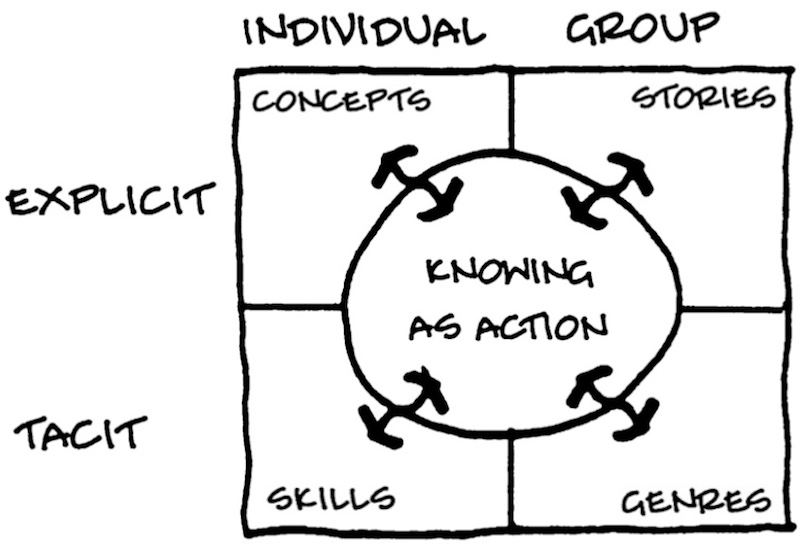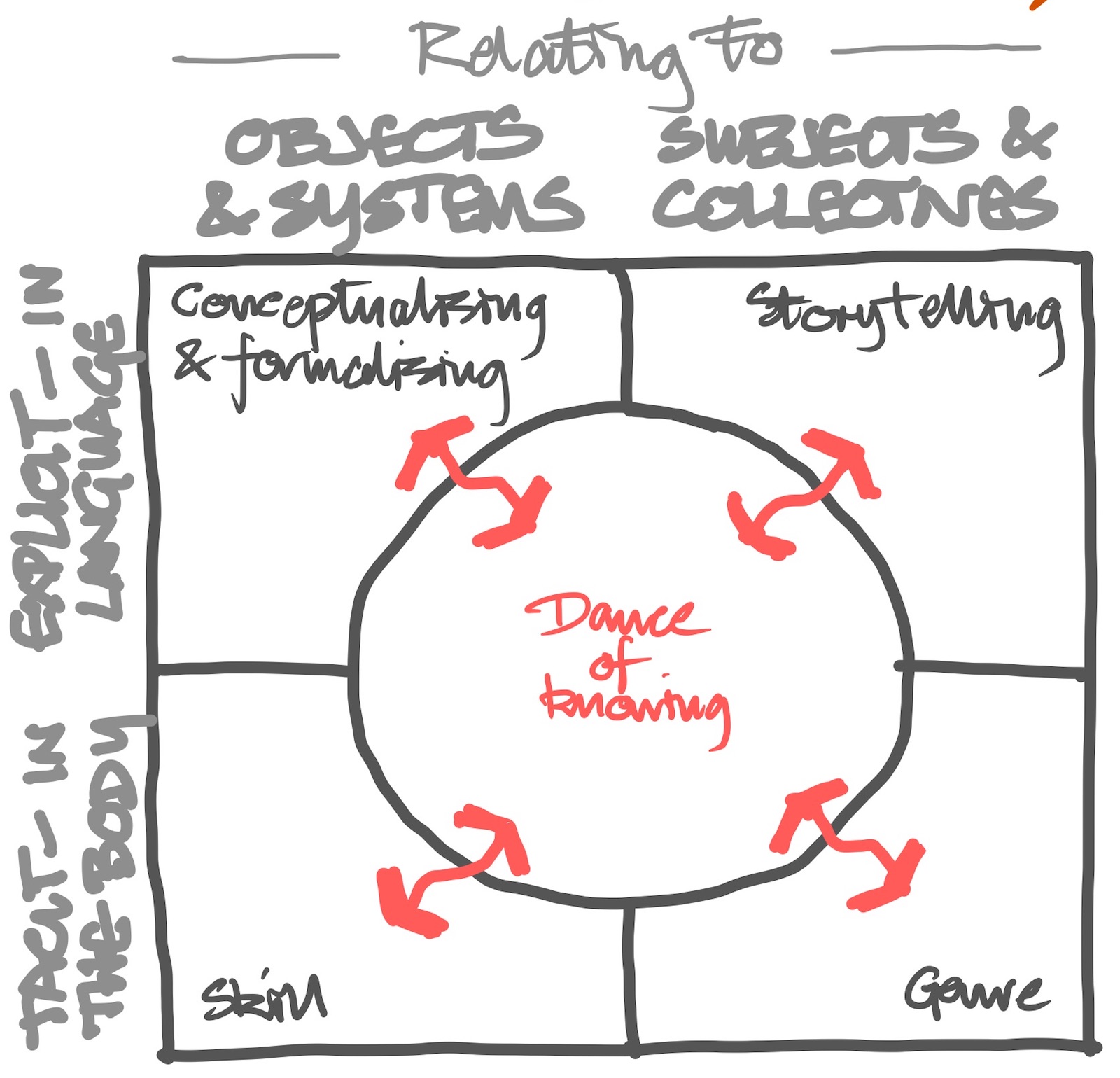# The generative dance of knowing
In conceptualising practices of cultural production we use a mapping of practice proposed by Noam Cook & John Seely Brown at Xerox PARC in the 90s. They call it 'the generative dance of knowing'.
> S. D. Noam Cook & John Seely Brown (1999), Bridging Epistemologies: The Generative Dance Between Organizational Knowledge and Organizational Knowing, *Organization Science* , August 1999, 10, 381-400. DOI: 10.1287/orsc.10.4.381 pdf ![]()
They proposed that we engage with four components of knowing and capability, constituted by individual and group practice on one hand, and by explicit talking-about and tacit doing on the other. The schema warrants some fine tuning, which we'll come to below.
Their main, important, emphasis was on the 'generative dance' that skilfully and continuously weaves a choreography through all four quadrants.
This is the most compact but richly expansive conceptual container that I know of, for bringing a radical, worker-centred, practice-centred focus on formaciòn: the production of activist cultural formations and activist capability.
It was a concrete, textured, context-aware, practice-oriented response in the burgeoning field of ’knowledge management’. At that time the hegemonic orientation in the field was corporatist, presuming that formalisation and codification were the road to follow - for example, creating ‘expert systems’ that would ‘capture’ and automate the organisation’s knowledge.
There is ‘dance’ imagery here that feels central in the aesthetic I'm seeking to cultivate in 'theory of practice', and the foprop frame it apears in numerous forms. Although I was working with 'dance' broadly from the beginning of the 90s, the explicit usage - and this four-quadrants-and-a-hub schematic form - came in the first place from Cook and Brown, whoise pre-publication paper I met in 1998, thro my contacts at PARC.
# Evolving the schema
Their ‘dance of knowing’ schema acknowledges the ways in which forms of **language practice** (*explicit* engagements of knowing - ‘above the line’ in the schema) can contribute in producing and mobilising knowing and capability. But importantly, it also gives matching weight to diverse forms of **in-the-body practice** (*tacit*, performed rather than verbalised - below the line).
It further acknowledges that engaging with worlds of **objects and systems** ‘on the left-side’ in the schema (physical, documentary, textual or bodily stuff) - in ways that an approach through codification or engineering, or a classically scientific approach might do - is a powerful and basic form of relationship with the world.
At the same time it acknowledges that this also and always - in actual practice - runs alongside engagements on-the-right-side of the schema, with worlds of **human subjects and communities**: in narratives, origin myths, stories of futures and ontologies, ‘news’, projections of mutual expectation and shared interest, memes, tropes that articulate valuations and aesthetics; genres of practices, entrenched institutions; and so on.
These more fine-grained understandings of the schema can be shown as in the version below.
This generates a 2x2 matrix, whose quadrants are tagged, for simplicity: conceptualising, storytelling, genre and skill. It's possible to do a lot of work using this mapping space. Note that in this version the 'content' of the frame comprises practices of knowing and capability, as distinct from the origianl version's idealist constructs of 'knowledge'.
**Rigour(s)** In each quadrant (and in the hub) there are different aesthetics, different rigours, distinct and different practices of valuing. Each has its own ways of **curating** and **stewarding the cultural commons**. Rigours, plural
Most fields of practice like to hunker down in one or another quadrant; some make a religion out of it - blockchainers or folksong fanatics, historians or engineers, actors or seat-of-the-pants managers, craftworkers or data-analytic wonks, line managers or trainers.
Part of the literacy of formaciòn is knowing what the different modes of rigour are, and how different forms of practice can be appropriately mobilised alongside one another in a weave, as a dance, in **enjoying** the distinctive - and combined - benefits of different cultural commons.
The activist 'dance' across the four modes constitutes altered knowledges, altered labour powers, altered formations. It's the meta-rigour of the hub - the dance itself, choreographing dances - that is the most important; and I guess, rarest. This is what activist formaciòn needs, to win out. Huge, deep plurality and choreographic scope.
At root, Making the living economy is done by commoning: a dance of curating, stewarding and enjoying. A great sweep of plural rigours and aesthetics, and meta-rigour.
> I’ll use the 'dance of knowing' schema here to characterise *pattern language(ing)*. My experience as a traveller in worlds of design and theory-of-practice (‘a methodologist’?) tells me that this is a kind of conceptual container that will do the job for theory-of-practice in a college of formacion, in a uniquely helpful and powerful way.

